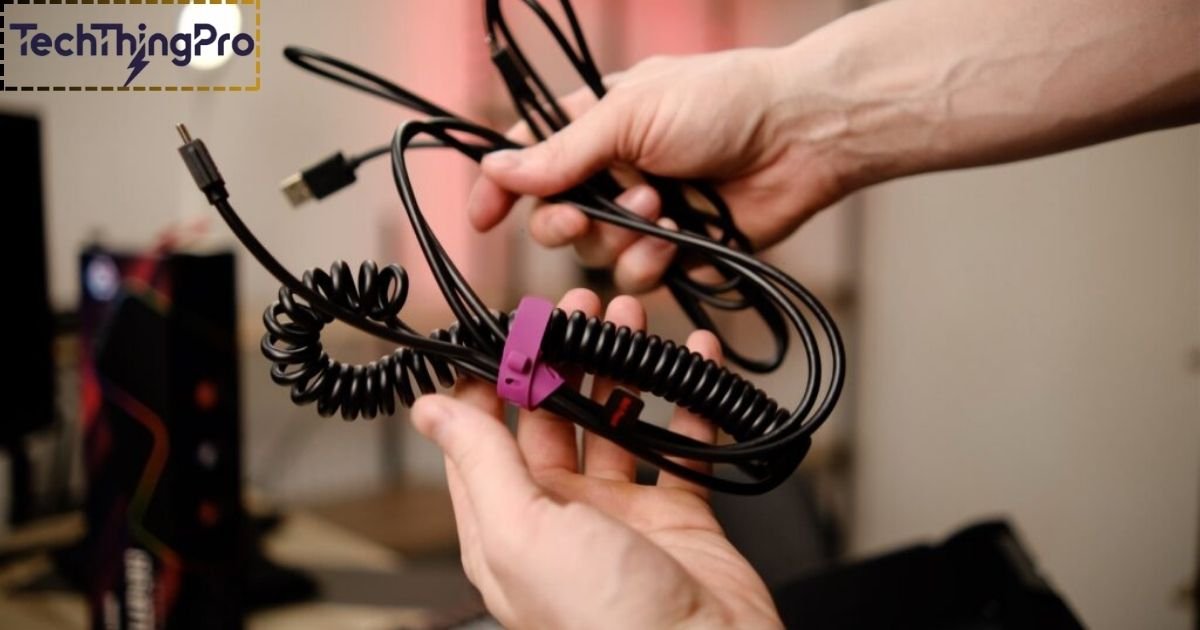Wired keyboard connects to your computer using a cable, offering a reliable and fast connection. These keyboards don’t rely on batteries and are known for their durability. The attached cable can limit mobility and clutter your desk.
You can turn your wired keyboard into a wireless version with USB receivers or Bluetooth adapters. This process involves adding a small transmitter and pairing it with your device. It’s a smart way to enjoy the benefits of wireless technology without buying a new keyboard.
Wireless Conversion Options
Turning your wired keyboard wireless can be done in two main ways: USB wireless receivers or Bluetooth keyboard adapters. Each method has its unique advantages and works well depending on your keyboard type and usage needs.
Using a USB-compatible keyboard adapter lets you connect your keyboard wirelessly via a receiver plugged into your computer. On the other hand, a Bluetooth dongle compatibility upgrade allows you to pair your keyboard with multiple devices. Both methods help reduce keyboard cable clutter and improve usability.
USB Wireless Receivers
A USB wireless receiver for the keyboard is one of the simplest options. These small devices act as bridges between your wired keyboard and your computer. After connecting the receiver, the keyboard communicates wirelessly over a short range. This setup is ideal for minimizing keyboard frequency calibration issues and ensures quick responsiveness.
One downside is limited compatibility with older keyboards. Some models might require soldering for connection, especially if you need to integrate a microcontroller for keyboard use. However, this method is easy to set up and doesn’t require specialized software.
Bluetooth Adapters
Using a Bluetooth keyboard adapter is another practical choice. This involves connecting a Bluetooth dongle compatibility device to your wired keyboard. Bluetooth offers greater flexibility by letting you pair the keyboard with laptops, tablets, and even smartphones.
While the setup is straightforward, you may face wireless keyboard latency issues or need to manage battery life carefully. For gaming enthusiasts, low-latency adapters are a must to avoid delays during intense gameplay. With proper setup, you’ll enjoy seamless device switching and enhanced mobility.
How to Make a Wired Keyboard Wireless?
Converting a wired keyboard to wireless can be a rewarding DIY project. It requires attention to detail and some basic tools. Here’s a step-by-step guide to help you:
Step 1: Disconnect Your Keyboard
Before starting, disconnect the keyboard and remove any attached cables. This step ensures safety during the modification process. Keep a portable keyboard solution handy if you need to work while modifying your main keyboard.
Disassembling your keyboard may involve unscrewing the back panel. Take care not to damage any internal components. If you notice issues like spills or wear, check for keyboard connectivity problems or water damage before proceeding.
Step 2: Insert USB-Compatible Microcontroller
A microcontroller for keyboard serves as the brain of your wireless setup. It translates signals from the keyboard to the receiver or Bluetooth adapter. Popular options include Arduino-based controllers, which are versatile and widely supported.
You may need to perform light soldering for keyboard modification to secure the microcontroller in place. Double-check all connections to avoid frequency interference, ensuring proper keyboard frequency calibration for optimal performance.
Step 3: Connect the Radio Transmitter
A radio transmitter setup enables your keyboard to send wireless signals. Attach the transmitter to the microcontroller, ensuring it aligns with the wireless receiver. Proper calibration minimizes wireless keyboard power management issues and improves signal strength.
Adjust the transmitter to reduce interference from other devices. This step is especially important if you’re working in an environment with multiple wireless gadgets.
Step 4: Try Using Your Keyboard Wirelessly
Once the hardware is set, test the connection. Plug the USB wireless receiver for the keyboard into your computer or pair the keyboard via Bluetooth. Troubleshoot any wireless keyboard battery life or connectivity problems as needed.
If you notice latency issues, ensure all components are secure. Gamers may need to fine-tune settings to reduce gaming keyboard wireless latency.
Read 📖 More: Wireless or Bluetooth Keyboards: Which Should You Choose?
How to Make USB Keyboard Wireless Bluetooth?
Turning your USB keyboard into a Bluetooth keyboard is another option. This method offers the added convenience of pairing with multiple devices, creating a compact wireless keyboard solution for on-the-go use.
Step 1: Purchase a Bluetooth Dongle
Choose a dongle compatible with your keyboard. Look for features like fast pairing, extended range, and support for multiple devices. The right dongle eliminates most troubleshooting wireless keyboard headaches.
Step 2: Connect the Bluetooth Dongle
Attach the dongle to your keyboard via the USB port. Ensure a snug fit for uninterrupted signals. This step is vital for avoiding issues like keyboard connectivity problems.
Step 3: Connect the Keyboard to Your Computer via Bluetooth
Follow the Bluetooth keyboard pairing steps for your device. Go to the Bluetooth settings on your computer, select your keyboard, and pair it. Once paired, test the connection to ensure stability.
Should You Make a Wired Keyboard Wireless?
Transforming a wired keyboard to wireless has many benefits. It reduces keyboard cable clutter, enhances workspace aesthetics, and makes your setup more flexible. For those prioritizing mobility, a portable keyboard solution is a game-changer.
However, wireless keyboards may introduce challenges like wireless keyboard power management and signal interference. Before committing to a conversion, weigh the advantages against these potential drawbacks.
Clutter-Free Workspace
One of the biggest perks of a wireless setup is a clean desk. You no longer need to deal with messy cables, creating a professional and organized space.
Enhanced Mobility
A wireless keyboard allows you to work or game from any position. This freedom improves comfort and enables better focus.
Tech Aesthetics and Multi-Device Support
Upgrading your keyboard adds style to your setup. You can also easily switch between devices, making this option perfect for multitaskers.
Common Issues When Making a Wired Keyboard Wireless and Solutions
Converting a wired keyboard to wireless can bring challenges. From technical difficulties to environmental factors, many issues can arise during and after the process.
Knowing these common problems and their solutions ensures a smoother transition. Let’s dive into some of the most frequent issues and how to address them effectively.
Connectivity Problems
One of the most common issues in wireless keyboard conversion is connectivity. Poor signal strength, interference from nearby devices, or improperly paired hardware can cause this problem.
To solve it, check the alignment between the USB wireless receiver for keyboard or Bluetooth keyboard adapter and the keyboard. Removing other wireless devices or changing channels can also minimize interference.
Additionally, ensure that your receiver or adapter is positioned close to the keyboard for optimal performance. Weak signals can often be corrected by adjusting the positioning or using an external antenna.
Power Issues
Power management is critical for a wireless setup. Many users experience problems with battery usage or power delivery. Some keyboards may drain batteries too quickly, making it inconvenient for daily use. Investing in a wireless keyboard power management system, like rechargeable batteries or low-energy transmitters, can solve this issue.
Make sure your keyboard is equipped with a power-efficient microcontroller. If your keyboard isn’t responding, check the battery connections and charge levels first. These simple steps often resolve power-related disruptions.
Water Damage
Liquid spills are a universal problem, whether the keyboard is wired or wireless. However, wireless components like radio transmitter setups and batteries are more vulnerable to water damage. If your keyboard gets wet, disconnect it immediately and let it dry completely.
Use isopropyl alcohol to clean the affected areas, especially around the microcontroller for keyboard. For severe cases, replace the damaged components to restore functionality. Taking preventive measures, like using waterproof covers, can save your keyboard from future mishaps.
Frequency Controlling Issue
Frequency interference can happen when multiple wireless devices share the same bandwidth. This is particularly noticeable in environments with many Bluetooth or radio-frequency devices. Proper keyboard frequency calibration ensures your keyboard and receiver are synchronized.
Manually setting the frequency or changing the receiver’s channel can resolve this issue. Some advanced adapters also allow for automatic calibration, which simplifies the process.
Latency Issue
Wireless keyboard latency issues can make typing or gaming frustrating. Delays between key presses and on-screen responses usually result from poor signal quality or low-quality transmitters. Using a high-quality adapter or low-latency Bluetooth dongle minimizes this problem.
Gamers, in particular, should choose adapters designed for gaming keyboard wireless latency reduction. Regularly updating the firmware of your microcontroller and receiver can also improve response times.
Compatibility Issue
Not all keyboards are suitable for wireless conversion. Older models may lack the necessary ports or drivers to work seamlessly with a wireless setup. Incompatibility often arises when pairing a Bluetooth keyboard adapter with unsupported devices.
To address this, check the specifications of your keyboard and adapters before purchase. Modern USB-compatible keyboard adapter options typically support a wide range of devices. Additionally, ensure your operating system has the correct drivers installed for smooth operation.
Battery Life
Battery life is a critical factor in wireless keyboards. Frequent recharging or replacing batteries can become a hassle. Selecting energy-efficient components during conversion, like a power-saving microcontroller or rechargeable battery packs, can improve longevity.
Monitor your keyboard’s usage patterns to optimize power settings. Simple tweaks, such as turning off the keyboard when not in use, can significantly extend battery life. Comparing wired vs wireless keyboard setups reveals that proper management minimizes battery-related inconveniences.
Conclusion
Turning a wired keyboard into a wireless one can be a rewarding DIY project. With the right tools like USB wireless receivers, Bluetooth adapters, and proper power management, you can enjoy a clutter-free and portable setup. Whether it’s for gaming, work, or aesthetics, the benefits of a wireless keyboard are undeniable.
It’s essential to understand potential issues like latency, compatibility, or connectivity problems. By following the steps carefully and choosing quality components, you can create a reliable and efficient wireless keyboard solution.

Lily Watkins is an experienced tech writer specializing in the latest trends and innovations. She is passionate about making complex technology accessible and shares her insights on TechThingPro.com.

